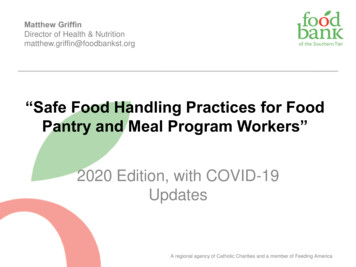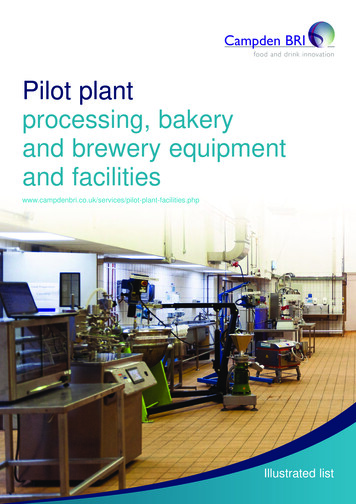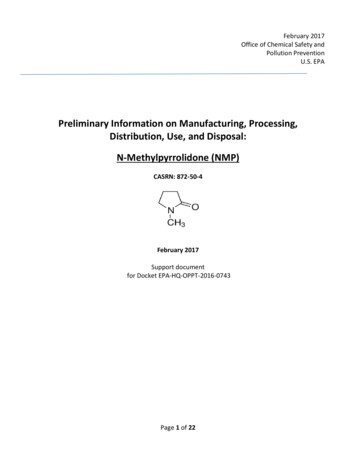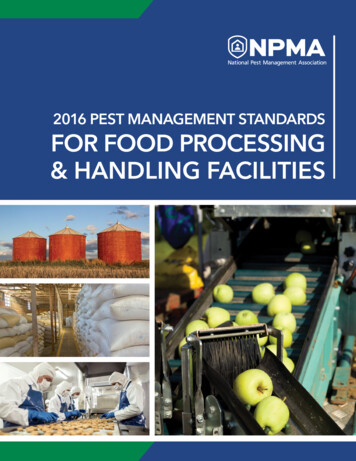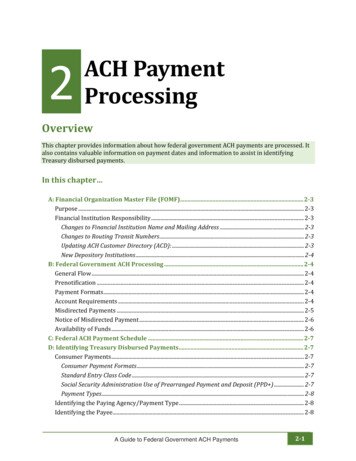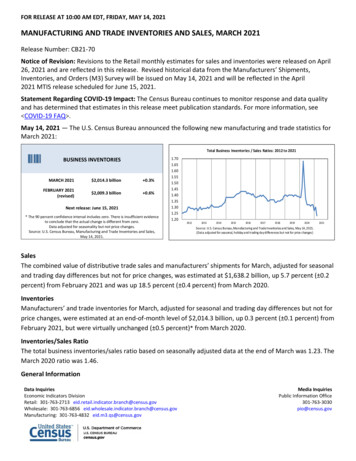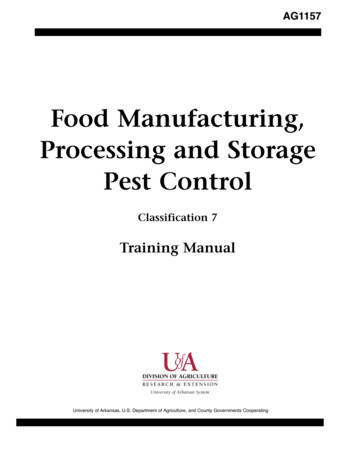
Transcription
AG1157Food Manufacturing,Processing and StoragePest ControlClassification 7Training ManualUniversity of Arkansas, U.S. Department of Agriculture, and County Governments Cooperating
Edited byDr. John D. Hopkins, Associate Professor and Extension Entomologist,University of Arkansas Division of Agriculture.ContributorsDr. John D. Hopkins, Associate Professor and Extension Entomologist,University of Arkansas Division of Agriculture.Dr. Becky McPeake, Professor andExtension Specialist-Wildlife, Universityof Arkansas Division of Agriculture.2
PrefaceThis manual provides information for the Arkansas commercial pesticide applicator wishing tobecome certified in Food Manufacturing, Processing and Storage Pest Control – Classification 7. Tobecome a certified applicator in this category, a candidate must pass both a general standards exam andpass an examination based primarily on the material presented in this manual and (Circular 6)Arkansas Pest Control Law (Act 488 of 1975, as amended). Information covered in the general standardsexamination is contained in A Guide for Private and Commercial Applicators: Applying PesticidesCorrectly. Refer to (Circular 6) Arkansas Pest Control Law (Act 488 of 1975, as amended) for specificrequirements. The Arkansas State Plant Board administers the examinations. Up-to-date study mate rials can be obtained from the Arkansas State Plant Board, #1 Natural Resources Drive (P.O. Box 1069),Little Rock, AR 72203-1069, phone (501) 225-1598. Additional study information may be obtained fromthe University of Arkansas Cooperative Extension Service, the pesticide label, current publications onthe subject, pesticide distributors and manufacturers.AcknowledgmentsInformation accumulates from direct observations, scientific literature and anecdotes from others.Information from these sources blurs together quickly, and consequently, unique ideas are rare in society.Credit for sources of information on urban pest control and management must go to Land GrantUniversity Extension and research workers, most of whom are entomologists, who pioneered this work,those who kept training and research alive during the period when the success of synthetic organic pesti cides preempted nearly all but control evaluations from the 1940s to the 1960s, and those who persisttoday; Pest Control Industry workers who held training sessions nationally, regionally and locally whereinformation was disseminated among the experienced and provided to the inexperienced; EnvironmentalProtection Agency personnel who molded modern training and influenced the need for national unifor mity in training requirements; state regulatory personnel who cooperated with universities and industryand who strongly emphasized the importance of training; and the few textbook authors in the UnitedStates and England who compiled the reference data in the understandable and usable form that allowsurban pest management practitioners to be professionals.Portions of this manual have been adapted from commercial applicator certification training manualsfor general pest control developed by the Oklahoma Cooperative Extension Service, Division ofAgricultural Sciences and Natural Resources, Oklahoma State University; Texas Agricultural ExtensionService, the Texas A&M University System; and University of Nebraska Cooperative Extension,University of Nebraska-Lincoln. Also, special thanks go to Dr. Jim T. Criswell and Dr. Melinda Crockett,Oklahoma State University, Oklahoma Cooperative Extensive Service; Dr. Don L. Renchie (TexasCooperative Extension); Dr. Grady J. Glenn (Center for Urban and Structural Entomology), Texas A&MUniversity System; and Dr. Clyde L. Ogg, Extension Educator-Pesticide Education, University ofNebraska Cooperative Extension.Specific acknowledgments should go to the anonymous biological illustrators who graphically renderpest and beneficial animals where photographs fail.The pesticide information presented in this publication was current with federal and state regulations at the time of printing. The useris responsible for determining that the intended use is consistent with the label of the product being used. Use pesticides safely.Read and follow label directions. The information given herein is for educational purposes only. Reference to commercial products ortrade names is made with the under standing that no discrimination is intended and no endorsement by the Cooperative ExtensionService is implied.3
Table of ContentsPage No.Food Manufacturing, Processingand Storage . . . . . . . . . . . . . . . . . . . . . . . . .5Overview of Managing Pest Problems inFood Related Facilities . . . . . . . . . . . . . . . .5Building Design . . . . . . . . . . . . . . . . . . . . . .5Creation of In-Plant SanitationProgram . . . . . . . . . . . . . . . . . . . . . . . . . . . .9Inspection Observation Routine . . . . . . . .11Specialized Plant Inspections . . . . . . . . . .12Food Manufacturing, Processingand Storage Integrated PestManagement . . . . . . . . . . . . . . . . . . . . . . .13What Is lPM? . . . . . . . . . . . . . . . . . . . . . . .13What Regulates Storability? . . . . . . . . . .13Monitoring Tools . . . . . . . . . . . . . . . . . . . .15Trap Design and Attractants . . . . . . . . . .15Future Applications . . . . . . . . . . . . . . . . .16How to Use Insect Traps ina Warehouse . . . . . . . . . . . . . . . . . . . . . . .16A Plan for Pest Management for thePopcorn and Seed Industry . . . . . . . . . . .19Pesticide Labels, Applicationsand Regulations . . . . . . . . . . . . . . . .21Labels . . . . . . . . . . . . . . . . . . . . . . . . . . . . .21Applications . . . . . . . . . . . . . . . . . . . . . . . .21Pesticide Regulations . . . . . . . . . . . . . . . .22Pesticide Residues . . . . . . . . . . . . . . . . . . .22Pesticide Tolerances . . . . . . . . . . . . . . . . .23Site Names . . . . . . . . . . . . . . . . . . . . . . . .23USDA Meat Plants . . . . . . . . . . . . . . . . . .24Safety . . . . . . . . . . . . . . . . . . . . . . . . . . . . .25Insect Pests and Control. . . . . . . . . .26Moths . . . . . . . . . . . . . . . . . . . . . . . . . . . . .26Almond Moth . . . . . . . . . . . . . . . . . . . .27Indianmeal Moth . . . . . . . . . . . . . . . . .27Mediterranean Flour Moth . . . . . . . . .27Mealmoth . . . . . . . . . . . . . . . . . . . . . . .28Beetles and Weevils . . . . . . . . . . . . . . . . .28Lesser Grain Borer . . . . . . . . . . . . . . .28Cigarette Beetle . . . . . . . . . . . . . . . . . .29Drugstore Beetle . . . . . . . . . . . . . . . . .29Confused Flour Beetle . . . . . . . . . . . .294Page No.Red Flour Beetle . . . . . . . . . . . . . . . . .30Sawtoothed Grain Beetle . . . . . . . . . .30Merchant Grain Beetle . . . . . . . . . . . .31Foreign Grain Beetle . . . . . . . . . . . . . .31Rusty Grain Beetle . . . . . . . . . . . . . . .32Spider Beetles . . . . . . . . . . . . . . . . . . .32Warehouse Beetle . . . . . . . . . . . . . . . .33Other Dermestid Beetles . . . . . . . . . .33Cockroaches . . . . . . . . . . . . . . . . . . . . . . . .34Identification of Cockroaches . . . . . . . . . .34German Cockroach . . . . . . . . . . . . . . .34American Cockroach . . . . . . . . . . . . . .35Oriental Cockroach . . . . . . . . . . . . . . .35Brown-banded Cockroach . . . . . . . . . .35Flies . . . . . . . . . . . . . . . . . . . . . . . . . . . . . .36Ants . . . . . . . . . . . . . . . . . . . . . . . . . . . . . .36Bees and Wasps . . . . . . . . . . . . . . . . . . . . .36Other Occasional Insect Pests . . . . . . . . .36Booklice . . . . . . . . . . . . . . . . . . . . . . . .36Silverfish and Firebrats . . . . . . . . . . .37Crickets . . . . . . . . . . . . . . . . . . . . . . . .37Ground Beetles . . . . . . . . . . . . . . . . . .38Other Arthropods . . . . . . . . . . . . . . . . . . .38Sowbugs and Pillbugs . . . . . . . . . . . . .38Rodents and Their Control. . . . . . . .39Senses, Agility and Reactionsof Rodents . . . . . . . . . . . . . . . . . . . . . . . . .39Recognizing Rat and Mouse Signs . . . . . .39Rodent Management . . . . . . . . . . . . . . . . .41Equipment And ApplicationTechniques . . . . . . . . . . . . . . . . . . . . . . . . .56Sprayers . . . . . . . . . . . . . . . . . . . . . . . . . . .56Dusters . . . . . . . . . . . . . . . . . . . . . . . . . . .58Space Treating Equipment . . . . . . . . . . . .59Respiratory Protection. . . . . . . . . . . .64Air-Purifying Respirators . . . . . . . . . . . . .64Approval of Air-Purifying Respiratorsfor Pesticides . . . . . . . . . . . . . . . . . . . . . . .65Air-Supplying Respirators . . . . . . . . . . . .65Selected References andStudy Material . . . . . . . . . . . . . . . . . . . . .68Glossary . . . . . . . . . . . . . . . . . . . . . . . . . . .69
Food Manufacturing, Processingand StorageOverview of ManagingPest Problems in FoodRelated FacilitiesManagement of pests in food processingfacilities requires a high degree of professionalknowledge combined with experience. Pestmanagement includes many items in addition topesticides. A good definition for pest manage ment: IPM is the integration of chemical,physical, cultural and biological controls into asystem that minimizes health, economic andenvironmental hazards. Some have statedpesticides are to be used as the last resort or asa method to correct a serious problem.One of the first steps in managing pests infood plants is a well-constructed building.Preventive design and maintenance is anextremely valuable tool and first step in pestcontrol. When preventive design/construction isnot possible, then steps must be taken to applypreventive measures to existing facilities todecrease pest problems.Food plants must employ daily, ongoing pestmanagement programs including record keepingto monitor both effectiveness and legality of pestmanagement.The pest management program must bedirected against the threat of pests not only inthe facility but also from surrounding areas.Pests may be introduced to the facilities viaincoming ingredients, materials and transporta tion vehicles. Pest management must be directedat preventing favorable environments for thepest to develop.The first step in pest management for a foodprocessing facility is design and construction toeliminate pest entry and harborage. Withoutthis step, the pesticide applicator is workingfrom a deficit situation in which the applicatoris on a continuous treadmill of trying to catch upwith the problem.The applicator must also be very aware offederal and state regulations regarding the useof pesticides in a food processing facility. Thiscan include the Food and Drug Administration(FDA), United States Department ofAgriculture’s Food Safety Inspection Service(USDA-FSIS), Environmental Protection Agency(EPA), Occupational Safety and HealthAdministration (OSHA) and Department ofTransportation (DOT). There may be more thanone state agency that will be inspecting the foodplant also. In Arkansas, the Arkansas StatePlant Board, the Arkansas Department ofHealth (ADH) and the Arkansas Department ofEnvironmental Quality (ADEQ) will either beinspecting the plant or affecting pesticideselection and/or application.Many food plants also have strict guidelinesfor which pesticides can be used in the plantand where the pesticide(s) can be used. In addi tion, the food plant’s contractors may havefurther restrictions on pesticide use regardingthe processing of the contractor’s product. Theapplicator must be aware and follow all ofthese requirements.Building DesignThrough the engineering design of thebuilding, pest prevention will be made easier.The design includes not only the building, wallsand interior but also the exterior landscaping,drainage and where usable materials will bestored and, very importantly, where unusable(trash) materials will be stored outside. Thelocation of property lines can be very importantif a food plant’s neighbor does not practicesanitation or is a business which will provideharborage for pests.Short grass, neatly trimmed shrubs, pavedaccess ways and proper drainage are some of theenvironmental management strategies that helpreduce or eliminate shelter areas for most pests.Rodents are further discouraged by surroundingthe building foundation with an 18- to 24-inchstrip of 1-inch gravel in a trench six (6) inchesdeep. This also makes an excellent area for trapsand bait stations. If the bottom of the trench islined with roofing paper, weed growth isreduced. A soil sterilant may be used as asurface treatment.Building design or remodeling for pestprevention involves building framing,construction materials and building services.It is important to keep framing four inches or5
more away from walls so that inaccessible voidsare not designed into the building. Where voidscannot be prevented, the voids should be filledwith polyurethane foams coated with epoxyfiller or similar materials. Steel column floorjunctions should be grouped and sloped 60 tofacilitate cleaning. Reinforced concrete framingshould not leave ledges for dust, should be freeof pits, crack and crevices and sealed andpainted where necessary.Concrete is suitable for floors, but if notproperly poured, concrete will crack and holddust. Coating the floor will help aid in sanita tion. The concrete must be cured and the surfacemust be sandblasted, ground or acid-etched andprimed with the recommended bonding materialbefore the coating is applied. The type of serviceneeded will determine the coating required.Wet processing areas require acid-proof orbrick floors for easy cleaning and resistance toerosion. If the floor will be exposed to largequantities of running water or harsh chemicals,the concrete substrate should be protected fromerosion with an asphalt membrane over whichthe tile cement is applied before laying tiles andgrouting. Good epoxy or acid-proof grouts mustbe carefully and smoothly applied to the joints,which should be no more than 1/4 inch wide toreduce water penetration and pest shelter.Nonprod
Arkansas Pest Control Law (Act 488 of 1975, as amended). Information covered in the general standards examination is contained in . A Guide for Private and Commercial Applicators: Applying Pesticides Correctly. Refer to (Circular 6) Arkansas Pest Control Law (Act 488 of 1975, as amended) for specific requirements. The Arkansas State Plant Board administers the examinations. Up-to-date

